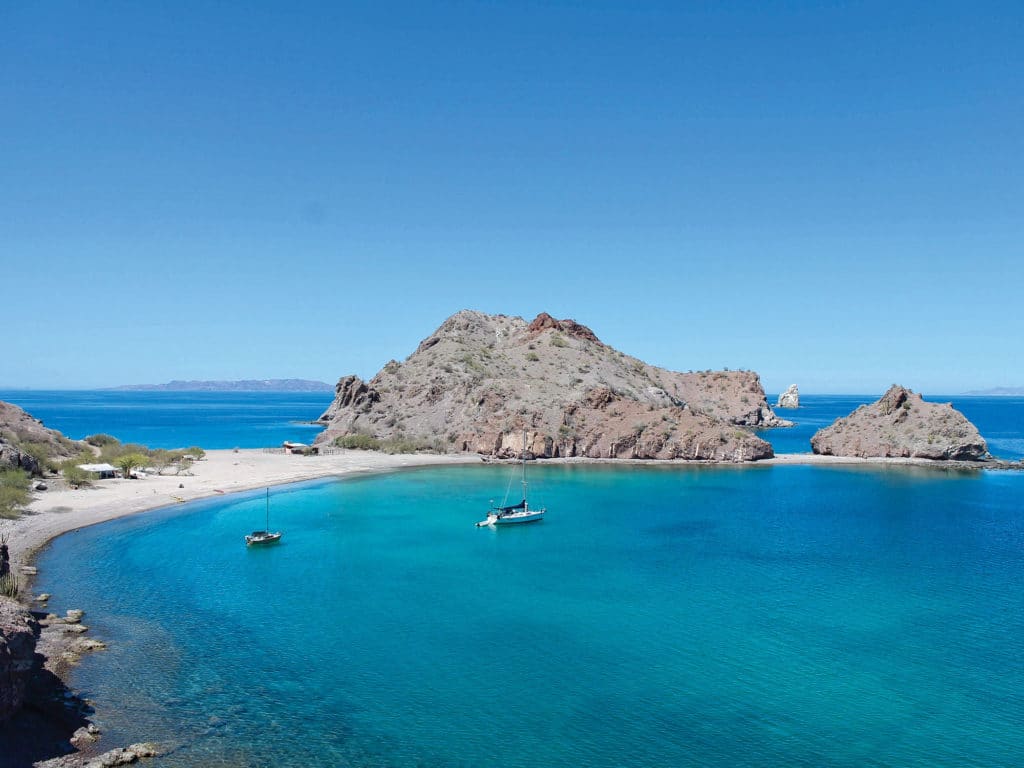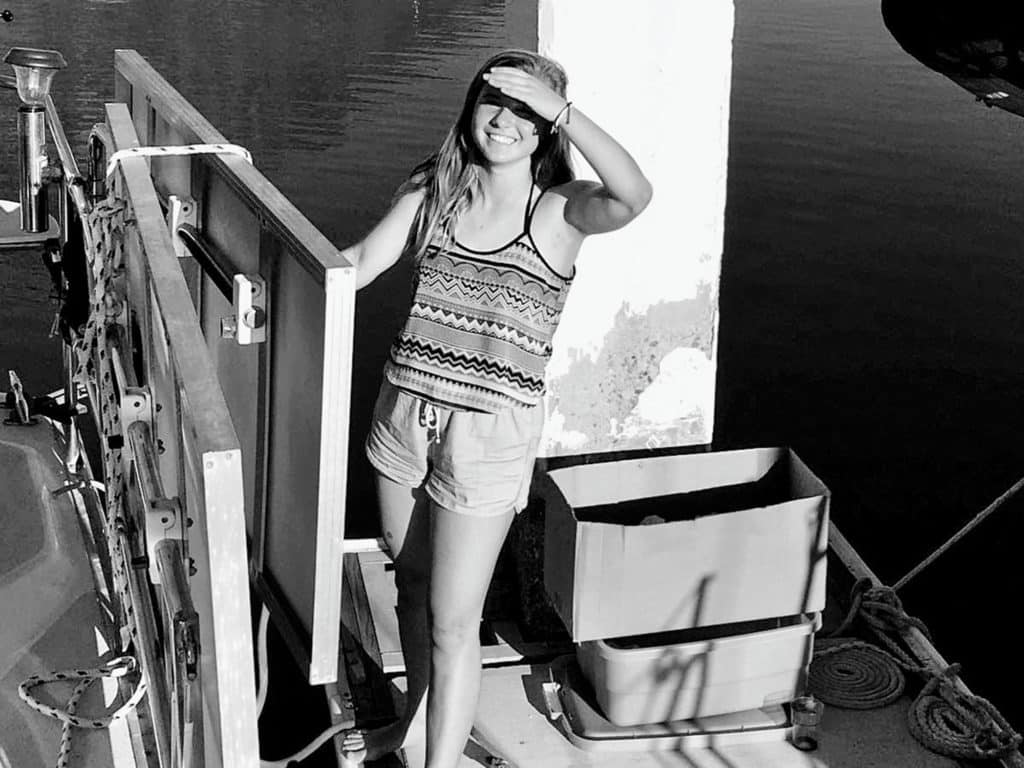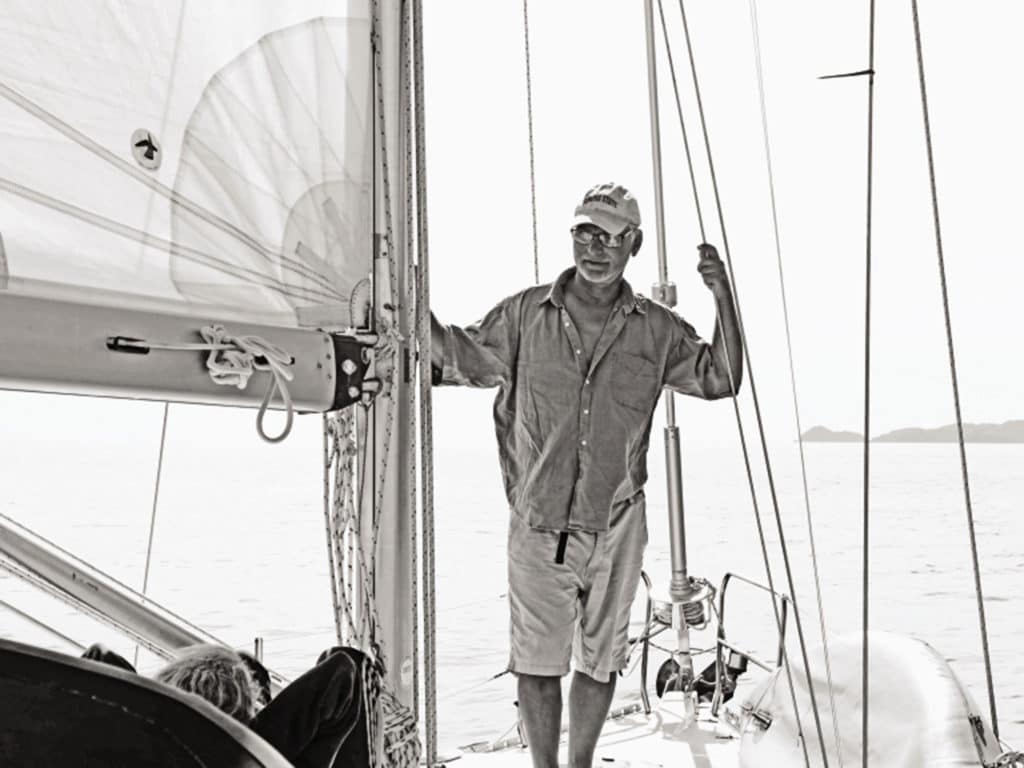
Any sailor with even the mildest case of wanderlust has gazed longingly at the gentle curve of a tabletop globe, tracing imaginary routes from their hometowns to faraway ports with the tips of their fingers. For West Coast sailors, these lines are likely to lead south; perhaps meandering along Baja’s rugged Pacific coast and turning the corner at Cabo San Lucas, headed for a place where the water is said to be bluer, the air warmer, the fish just a bit more colorful.
This magical place, of course, is the Sea of Cortez. And if that narrow strip of water tucked between mainland Mexico’s Sonoran Desert and the Baja’s beckoning finger is, in fact, the setting of your cruising daydreams, then you are in luck, because exploring the sea has never been easier. After all, we live in a time when every bit of information necessary for an extended sailing journey—from downloadable charts and safety guides to anecdotal what-to-expect articles—is just a quick Google search away.
This wealth of easily accessible information has made traveling around the Sea of Cortez, by sailboat or otherwise, not only easier, but far more popular. Tourism has been steadily rising for years. While this growing popularity has boosted local economies and allowed for more people to experience the beauty of Mexico’s most ecologically diverse body of water, increasing international traffic has also put a strain on the natural environment, potentially putting the very things that have drawn so many of us to the sea at risk.
My impression of the Sea of Cortez, after my family’s first cruising season there nearly three years ago, was that it was a body of water absolutely brimming with life. It did not take long for me to realize how skewed my perception was by my unfamiliarity with the environment and its history. Seasoned cruisers were quick to inform me that while the sea is still home to an exceptional quantity of wildlife, the decline just over their lifetimes has been evident and indisputable.
I spent many hours of that first winter lying in the sun on the foredeck, fantasizing about the wonders these sailors were fortunate enough to witness in the earlier years of traveling. As a 19-year-old on the first leg of what hopefully will be a lifetime of voyaging, I was saddened by the thought that I may have already missed out on the golden years of cruising, when our oceans were still healthy and flourishing. Sadder still was the thought of what the sea could look like in the next five to 10 years, when I hope to return on my own sailboat.
Will it still be legal—or possible—to fish in the Sea of Cortez? I would wonder, as the Mexican sun beat down on my skin. Will this place that I have come to know and love so much even be recognizable in 10 years? And what could I possibly do to make sure that it is? While these doubts might be discounted as the overdramatic musings of a teenage girl, there are many people in Mexico—and the world over—asking the very same questions.
Cruisers and the Sea

I was lucky enough to meet a few of these like-minded people this past spring, when a small group from the organization Grupo de Ecología y Conservación de Islas, A.C. came to San Carlos, Mexico, to speak to cruisers about how we can help keep the Sea of Cortez the pristine place we all know and love. They showed up in San Carlos with a presentation but no plan for where or when it would take place. With the help of the local cruising community, in less than a week the group was able to find a suitable venue and get the word out about the impromptu event.
When my brother and I walked into the bar where the talk was taking place, the owner had to grab extra seats from the outdoor dining area and shuffle the audience around just so we could sit down. The room was packed. When the presentation began, people in the audience asked questions and scribbled down notes. Cruisers shared stories of their own experiences with fishing regulations, protected areas and invasive species.
The speakers, who were mostly unfamiliar with the cruising lifestyle, reacted with curiosity and gratitude for the insights and fresh perspectives. The audience expressed their equally abundant gratitude by staying after the talk to chat with the presenters. It seemed as though every boat owner within 100 miles was not only present at the event, but also engaged, concerned and eager to learn more about the state of their beloved sea.
I walked away feeling hopeful and inspired. I had learned a great deal about the surrounding ecosystem and my place in it. But more important, I had learned that other sailors genuinely care about the changes going on in the water beneath their hulls. Inspired by this realization, I decided to share Conservación de Islas’ message with the broader sailing community. The result is a cruising guide of sorts, written not for your benefit, fellow cruiser, but for the benefit of your future cruiser grandbabies.
Beware of Hitchhikers
Rats and other unwelcome stowaways are a danger to more than sailors’ sanity when cruising in the Sea of Cortez. Invasive rodents, as well as seeds from certain invasive plants, pose a tremendous threat to the biodiversity of the sea’s many islands. One well-known invasive rodent is the black rat. Also known as the “ship rat,” these pesky little hitchhikers have been the cause of many a gray hair for sailors for hundreds of years. If you happen to find and catch a rat aboard your vessel, however, think twice before tossing it overboard in triumphant glee. Black rats are incredibly resilient and can swim up to a mile in open water. If they make it to an island, they are likely to throw off the delicate balance of their new ecosystem by preying on native seabirds.
My initial assumption after learning about the ship rat’s diet of choice was that sea life would flourish in response to a decrease in these predatory birds. It turns out, the opposite is true. The nutrient-rich guano produced by seabirds makes up an essential part of the underwater food chain. When there is less guano making its way into the sea, small fish that rely on it lose a vital food source and begin to die off. When little fish disappear, bigger fish—the ones we like to eat—are always close behind.
Sadly, the best way to safely get rid of rats is to kill them. The thought of ending a rat’s life might be unpleasant, but far more animals are put at risk when invasive rodents take up residence in island habitats.
RELATED: Sailing Totem: Cruising Untethered in the Sea of Cortez
Not all invasive species make their presence known when hitching a ride on your vessel. Invasive plant seeds can find their way from the mainland to islands by silently clinging to the bottom of an unwitting sailor’s shoes. Once their roots are set in island soil, invasive plants compete with native flora for resources, often crowding them out completely and limiting the food supply of native herbivores. The invasive buffel grass, commonly found throughout the Sonoran Desert, spreads quickly, creating grasslands that not only lack biodiversity, but also increase the risk of wildfires in areas where they would otherwise be rare. Conservación de Islas recommends keeping a mat on deck or in your dinghy so that it is easy to wipe seeds off your shoes before stepping onto islands or back onto your vessel.
Invasive marine invertebrates (think mussels and barnacles) often make their way to new environments by hitching rides on sailboat hulls and in ballast tanks. Make sure to give the entire underside of your vessel a good cleaning, and empty your ballast tank—if you have one—before entering Mexican waters to avoid transporting invertebrates from your home port to foreign environments.
The eradication of invasive species is a tedious and resource-intensive process. It is up to those who frequent the islands in the Sea of Cortez—cruisers being at the top of this list—to take preventative measures that will eliminate the need for eradication in the long run. A simple rule that sailors can follow is to bring as little as possible onto the islands we visit and leave nothing behind. This includes food scraps, such as orange peels and apple cores, that might be a source of food for invasive rodents.
Think Before You Fish
Remember that fishing regulations are in place for a reason. Marine protected areas were created to give ecosystems a chance to recover from the effects of overfishing and coastal development. While it’s true that sailors have played a relatively small part in the overfishing that has wreaked havoc on the Sea of Cortez, we can be respectful visitors by adhering to the regulations put in place to reverse its effects.
Over the six months I have spent island hopping in the Sea of Cortez, not once have I seen fishing regulations being enforced. Mexico’s environmental protection agency, Procuraduría Federal de Protección al Ambiente, is underfunded and spread incredibly thin when it comes to enforcing environmental law. As cruisers, we can help them out by making a conscious effort to remain aware of the laws as we make our way from anchorage to anchorage. One way to educate yourself is to talk to an official about the fishing regulations on the islands you plan to visit. Before visiting any of the sea’s protected islands, you’ll need to buy a permit at a Comisión Nacional de Áreas Naturales Protegidas office in either La Paz or Loreto, which provides the perfect opportunity to pick an environmental expert’s brain. They will have plenty of useful information and should be more than willing to share it.
If you enter the Sea of Cortez with so much as a single fish hook aboard your vessel, you will need to purchase a fishing license. This allows line fishermen to catch 10 fish per person per day. When fishing underwater with a spear gun or sling, this number goes down to five per person.
For most of us, this is a pretty generous limit. But it is important to note that stricter limits are placed on a few specific species: dorado, roosterfish, shad or tarpon, and gulf grouper. These have limits of two fish per person per day. And if you are lucky enough to catch any of these fish, it will count as five toward your daily 10-fish limit.
Visitors are also prohibited from catching mollusks and shellfish such as lobsters, mussels and clams. Unlike the catch limits on fin fish, some cruisers find this law harder to obey. Maybe the information is not known widely enough, or perhaps it’s hard for some to resist the urge to discreetly pick lobsters off the rocks when snorkeling. Regardless, it is an important rule to follow. Shellfish, as is much of the marine life in the Sea of Cortez, are in steep decline thanks to our hefty appetite for seafood.

There are no limits placed on catch-and-release fishing, as long as the fish are returned to the water in good shape. Even if you are not practicing catch-and-release, it is best to release fish that have not reached maturity. This gives them the opportunity to reproduce, helping to keep fish populations level over long periods of time. Become familiar with the average full-size length of the fish you catch most often, and stick to keeping only the fish that have clearly reached that length.
All the islands in the Sea of Cortez are protected and managed by CONANP, and have their own set of fishing restrictions. The use of spear guns and slings is prohibited in island waters. Line fishing is allowed in most areas on the islands, with a few exceptions. There are, though, no-take zones, where no fishing of any kind is allowed.
It is easy to get caught up in the excitement of reeling in a fish once the tug-of-war match has begun. Before you pull out the knife and start planning your fish taco dinner, stop and think about your catch. Have you reached your limit? Is the fish mature? Has it had a chance to reproduce? Are you in a no-take zone? If, after a moment of contemplation, you decide that the fish would do more for the sea than your dinner plate, consider releasing it.
When it comes to shrinking the collective cruising footprint, doing your part is relatively straightforward. In my eyes, it boils down to a simple combination of using common sense and staying informed. These tips are just a few examples of the countless ways we can work on treading lightly while voyaging. Do some Googling and get creative. Few stretches of coast on our blue planet are safe from the harmful effects of overfishing and invasive species, not to mention plastic pollution, coastal development and climate change. Researching location-specific environmental issues should be common practice when preparing for voyages anywhere in the world, not just in the Sea of Cortez.
One of the beautiful things about life at sea is the sense of accountability that comes along with being almost entirely off-grid. The illusory veil separating human life from the ocean is lifted by the cruising lifestyle. Being a steward of the sea can hardly be called activism by those of us drawn to a life afloat. Instead, we should recognize it as our job to protect the places we hold dear, in the hope that the coming generation may inherit the same sense of awe and wonder we feel every time we spin that tabletop globe.
Laura Belichak grew up sailing and surfing in Northern California, and after high school moved part time with her family aboard their Catalina 400, Circe, to spend the next four years cruising the Sea of Cortez. She is in the process of preparing her own boat, a Cal 2-27 named Wild, for her own extending sailing adventure. You can follow her at livingthewildway.com.








